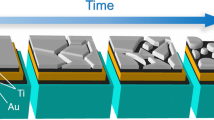Abstract
The objective of this paper is to explore both grid method and Digital Image Correlation (DIC) technique for microscale and discontinuous displacement measurements, such as those associated with crack tips. First, the principle of the grid method is revisited. The grid method and DIC technique are then applied to computer generated images to calculate the displacement field around crack tips. Finally, the grid method is applied to actual experimental images of fracture tests which are conducted inside a Scanning Electron Microscope (SEM) chamber. A new technique is developed to generate microscale pattern that is suitable for both grid method and DIC technique. The displacement fields calculated from grid method are compared with those from DIC technique to identify the strengths and weaknesses of each technique for the microscale and discontinuous displacement measurements. It has been determined that grid method can obtain data closer to the discontinuity than DIC; however, DIC produces smoother displacement fields at the far field. Using this new pattern generation technique, both grid method and DIC technique can be applied to the fracture test at the microscale to complement with each other to achieve the best experiment results.








Similar content being viewed by others
References
Miller JA (1952) Improved photogrid techniques for determination of strain over short gage lengths. Proc. Soc. Exp Stress Analysis 10(1):29–34
Parks VJ (1969) The grid method. Exp Mech 9(7):27N–33N
Parks VJ (1982) Strain measurement using grid methods. Opt Eng 21(4):633–639
Cox JA (1987) Point-source location using hexagonal detector arrays. Opt Eng 26(1):69–77
Fail WF, Taylor CE (1990) Application of pattern mapping to plane motion. Exp Mech 30(4):404–410
Sirkis JS, Taylor CE (1990) Displacement pattern matching and boundary-element methods for elastic-plastic stress analysis. Exp Mech 30(1):26–33
Sirkis JS (1990) System response to automated grid method. Opt Eng 29(12):1485–1493
Sevenhuijsen PJ (1993) The photonical pure grid method. Opt Lasers Eng 18(3):173–194. doi:10.1016/0143-8166(93)90026-H
Andersen K (1988) Strain tensor for large three-dimensional surface deformation of sheet metal from an object grating. Exp Mech 39(1):30–35
Dupré JC, Bremand F, Lagarde A (1993) Numerical spectral analysis of a grid: application to strain measurements. Opt Lasers Eng 18:159–172
Dupré JC, Cottron M, Lagarde A (1995) Grating interrogations: from small to large strain measurement. Exp Mech 35:153–158
Goldrein HT, Palmer SJP, Huntley JM (1995) Automated fine grid technique for measurement of large-strain deformation maps. Opt Lasers Eng 23:305–318
Sirkis JS, Lim TJ (1991) Displacement and strain measurement with automated grid method. Exp Mech 31(4):382–388
Wissuchek DJ, Mackin TJ, DeGraef M, Lucas GE, Evans AG (1996) A simple method for measuring surface strains around cracks. Exp Mech 36(2):173–179. doi:10.1007/BF02328715
Andresen K (1999) Strain tensor for large three-dimensional surface deformation of sheet metal from an object grating. Exp Mech 39(1):30–35. doi:10.1007/BF02329298
Barone S, Berghini M, Bertini L (2001) Grid pattern for in-plane strain measurement by digital image processing. J Strain Anal Eng Des 36(1):51–59. doi:10.1243/0309324011512603
Lavet C, Lapusta Y, Toussaint E, Labesse-Jied F & Poumarat G (2009) On measuring of overall mechanical properties of small animal bones using grid method. Int J Frac 159(1):85–92. doi:10.1007/s10704-009-9372-1
Peters WH, Ranson WF (1982) Digital imaging techniques in experimental stress analysis. Opt Eng 21:437–432
Sutton MA, Wolters WJ, Peters WH, Ranson WF, McNeill SR (1983) Determination of displacements using an improved digital image correlation method. Image Vis Comput 1(3):133–139
Chu TC, Ranson WF, Sutton MA, Peters WH (1985) Application of digital image correlation techniques to experimental mechanics. Exp Mech 25(3):232–244
Sutton MA, Cheng M, Peters WH, Chao YJ, McNeill SR (1986) Application of an optimized digital image correlation method to planar deformation analysis. Image Vis Comput 4(3):143–150
Bruck HA, McNeill SR, Sutton MA, Peters WH (1989) Digital image correlation using newton-raphson method of partial differential correction. Exp Mech 29:261–267
Jin H, Bruck HA (2005) Pointwise digital image correlation using genetic algorithms. Exp Tech 29(1):36–39. doi:10.1111/j.1747-1567.2005.tb00202.x
Jin H, Bruck HA (2005) Theoretical development for pointwise digital image correlation. Opt Eng 44:1–14. doi:10.1117/1.1928908
Poissant J, Barthelat F (2010) A novel “subset splitting” procedure for digital image correlation on discontinuous displacement fields. Exp Mech 50(3):353–364. doi:10.1007/s11340-009-9220-2
Pan B, Wang ZY, Lu ZX (2010) Genuine full-field deformation measurement of an object with complex shape using reliability-guided digital image correlation. Opt Express 18(2):1011–1023
Jin H, Lu WY, Korellis J (2008) Microscale deformation measurement using the digital image correlation and scanning electron microscope imaging. J Stra Ana Eng Des 43(8):719–728
Klein PA, MacFadden SX, Bammann DJ, Hammi Y, Foulk JW, Antoun BR (2003) A mechanism-based approach to modeling ductile fracture. SAND 2003-8804 (Sandia Report)
Abanto-Bueno J, Lambros J (2006) An experimental study of mixed mode crack initiation and growth in functionally graded materials. Exp Mech 46(2):179–196
Acknowledgement
Sandia is a multiprogram laboratory operated by Sandia Corporation, a Lockheed Martin Company, for the United States Department of Energy under contract DE-AC04-94-AL85000. Support provided by NSF under grant number DMR-0907122 is also greatly appreciated.
Author information
Authors and Affiliations
Corresponding author
Rights and permissions
About this article
Cite this article
Jin, H., Haldar, S., Bruck, H.A. et al. Grid Method for Microscale Discontinuous Deformation Measurement. Exp Mech 51, 565–574 (2011). https://doi.org/10.1007/s11340-010-9459-7
Received:
Accepted:
Published:
Issue Date:
DOI: https://doi.org/10.1007/s11340-010-9459-7




